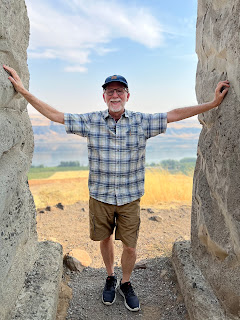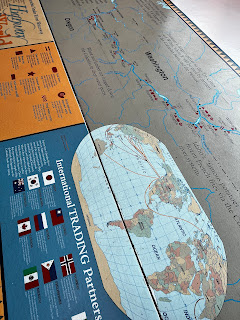A Visit With Family

After crossing the Canadian/US border back into Idaho, we enjoyed a relaxing week in Eastern Washington visiting our Grandson Jordan and his girlfriend Hannah. Due to the heatwave in the area we just relaxed and visited and enjoyed playing games together in the evening. It was a great time of getting to know them better!
Steve enjoyed checking out Jordan’s truck and car collection, including a fire truck!
Firestorms and A Change In Plans
As our visit with family in Eastern Washington drew to a close, extreme heat and fires breaking out all over the Pacific North West and California caused us to rethink the remainder of our journey. Instead of heading toward the Grand Tetons we made new plans to head west toward the coast of Oregon. That route seemed free of fires and the coastal breezes promised clear skies and good air quality!
Our route along the US Highway 84 took us beside the Columbia River, where we had been tracking the status of several fires. Along our drive we discovered that the Microwave Tower Fire had jumped a fire line and had come all the way down to the highway, which at that point was just two lanes each way and a railroad track tucked between the base of the smoky, fiery bluffs and the river!

A pair of air tankers flew over us and then skimmed the river to fill their tanks with water before heading back to drop water on the fire. Fortunately the fires along the road seemed to be under control, although we could see areas still affected by flames. While the road was not closed, one lane closest to the hill was shut down causing quite a long traffic delay. But that was on the opposite side of the highway from us!
The Dalles

After getting past the Microwave Fire Incident we stayed at an RV resort in the midst of a peach orchard right along the banks of the Columbia River!

From there we had no shortage of museums to choose from in and around The Dalles! As the air quality was so poor we limited our time outdoors and it was nice to have these indoor activities.
Just above our campground, on a bluff overlooking the river, there is a replica of Stonehenge which was built by Sam Hill. He erected this as the nation's first WWI memorial and it was dedicated in 1918 to the servicemen of Klickitat County, Washington, who died in the service of their country.



A short distance away is Mr. Hill’s residence, now the Maryhill Museum of Art which has a collection of more than 100 works of art and personal items from Marie, Queen of Romania. In addition we saw an extensive array of Native American artifacts and basketry, as well as sampling of a collection of 400 chess sets from many eras and regions.

Another fun place we visited was the National Neon Sign Museum. What made this extraordinary was the tour by the man who has researched, collected and curated this exhibit which follows the invention and history of the neon sign. You will see many one of a kind exhibits here and learn all about the invention and technology of the neon bulb!
Columbia River
Flowing 1,279 miles from the Canadian Rockies in British Columbia and down through the US to the Pacific Ocean at Astoria, Oregon, this mighty river is both majestic and dangerous. We have learned so much about the Columbia River. While in British Columbia we had seen the confluence of the Columbia and Kootenai rivers. Along its path through the Pacific Northwest, many other rivers join with the Columbia on its relentless path to the Pacific Ocean.
During a trip two years ago we traveled the historic highway of the Columbia River Gorge where we were amazed by this panoramic view displaying the size and scope of this magnificent waterway.

Corps of Discovery 1804-1806
After the Louisiana Purchase, Captains Meriwether Lewis and William Clark were commissioned by President Thomas Jefferson for the following task:
"The object of your mission is to explore the Missouri river, & such principal stream of it, as by it's course and communication with the waters of the Pacific ocean, whether the Columbia, Oregan, Colorado or any other river may offer the most direct & practicable water communication across this continent for the purpose of commerce."
-From President Jefferson's Instructions to Captain Lewis, 20 June 1803

Today the Columbia River is a modern day highway of commerce…to the world…with barges and tankers and container ships moving grain, oil, and more up and down the river and to far away ports around the globe!
I think the Journey of the Corp of Discovery undertaken by Lewis and Clark was more successful than they or Thomas Jefferson could even imagine!
Locks and Dams
The waterfalls and rapids of the Columbia River proved an obstacle to the emigrants on the Oregon Trail. Arriving at The Dalles they were faced with a difficult situation.
Should they hire rafts to move their wagons and goods over the treacherous rapids or travel by a new “shortcut” on a trail around Mount Hood? Some made the river choice and lost all, but some took the newly formed overland route which had its own difficulties! Getting our own look at the size of the river and seeing paintings of its rapids and waterfalls we are amazed that any of the pioneers made it beyond this obstacle!
Today the river's rapids and waterfalls have been modified by modern engineering of the Corp of Engineers. Years after Lewis and Clark's Corps of Discovery and the brave pioneers and settlers of the Oregon Trail traveled to this river, construction of Locks and Dams at rapids and waterfalls has provided for safer passage up and down the river. This has also brought a source of hydroelectric power for the region.
Columbia River Bar

Where the mighty force of the Columbia River meets the equally great power of the Pacific Ocean, is an area known as the “Shipwreck Capital of the World”, and the “Graveyard of the Pacific”! This is the Columbia River Bar, named “a specially hazardous area” by the Coast Guard. This hazardous waterway to the Ocean has a long history of uncounted ship wrecks.

The remains of one such shipwreck can be easily visited at Fort Steven’s State Park. The rusting steel bow of the 1906 wreck of the Peter Iredale draws many curious visitors. Children and adults alike are awed by the steel beams and posts rising from the sand. We even saw a pair of visitors arrive on horseback to pose with the iconic wreck!
It continues to take great skill to navigate these waterways. Despite the building of locks and dams and miles of jetties to deepen the river’s mouth and shelter the harbor, shifting sand bars still make it necessary for River Pilots to come aboard ships planning to travel the river. Without these brave and skilled Pilots navigating ships through the bar there would continue to be many disastrous shipwrecks!
Lightship Columbia
Of course lighthouses and lightships play an important role in making shipping along the rocky Oregon Coast safer.
We toured the historic Lightship Columbia, (a floating lighthouse) which served from 1951 until being decommissioned in 1979. During those years it was stationed at anchor six miles out to sea from the river’s mouth. Ships traveling into the river would have to navigate to the lightship and be provided with the current location of the safe route to navigate into the river. Today the ship has been replaced by a fixed automated navigational buoy.
Pray without Ceasing
We have been praying much for the firefighters, the evacuees, and those who have lost homes and businesses. Sadly an air tanker pilot was killed in a plane crash fighting one of the Oregon fires. Our hearts are also especially burdened for those in the town of Jasper, Canada, which we visited just a few weeks prior to the start of a horrific fire, which was touched off by lightning storms. Much of the town has been destroyed and the fire is continuing to burn in Jasper National Park. We know fires are also burning in California.
 We are so thankful that the Lord is directing our steps as we navigate around these fires and the areas impacted by smoke and unhealthy air quality.
We are so thankful that the Lord is directing our steps as we navigate around these fires and the areas impacted by smoke and unhealthy air quality.
Our next post will have more of our Adventures on the Road from the Oregon Coast!

 We are so thankful that the Lord is directing our steps as we navigate around these fires and the areas impacted by smoke and unhealthy air quality.
We are so thankful that the Lord is directing our steps as we navigate around these fires and the areas impacted by smoke and unhealthy air quality.



























No comments:
Post a Comment